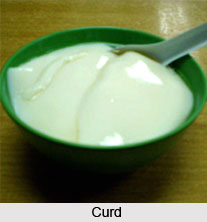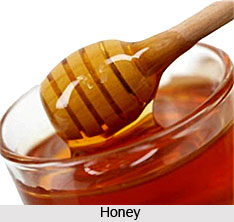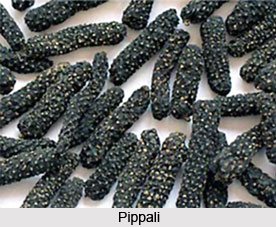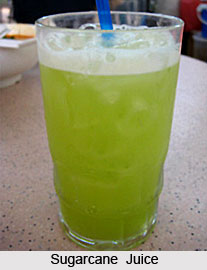 Vedic Food in ancient India comprised those food items that were effortlessly obtainable from nature. The Vedic literature throws considerable light on the food and drink habits of the people of the ancient societies, their garments and ornaments. Among the food grains, the Rig Veda repeatedly mentions barley, particularly fried barley. Of frequent occurrence is the word `anna` which may not essentially mean rice; it denotes food in general. Dhanya has also been mentioned, saktu (pulverised grain) was commonly used. Ksirapakva anna, apupa (cake) appear to have been delicacies and crushed grain, mixed with curd, was also relished. Puroddsa (a kind of cake) was used in sacrificial offerings.
Vedic Food in ancient India comprised those food items that were effortlessly obtainable from nature. The Vedic literature throws considerable light on the food and drink habits of the people of the ancient societies, their garments and ornaments. Among the food grains, the Rig Veda repeatedly mentions barley, particularly fried barley. Of frequent occurrence is the word `anna` which may not essentially mean rice; it denotes food in general. Dhanya has also been mentioned, saktu (pulverised grain) was commonly used. Ksirapakva anna, apupa (cake) appear to have been delicacies and crushed grain, mixed with curd, was also relished. Puroddsa (a kind of cake) was used in sacrificial offerings.
In the Vedic texts, among drinks are mentioned wine and somarasa; the latter was, perhaps, used by the upper classes, particularly in sacrifices. Dadhimantha perhaps means liquefied curd or clarified butter. Milk (kslra), curd (dadhi) and ghee had also been mentioned. The Vedic texts also mentions the usage of the meat of bulls, horses, buffaloes and even of dogs is proved. Madhu (honey) appears to have been used as an article of food in this age. A preparation of fried rice, called laja, is mentioned. The Veda also testifies to the wide prevalence of drinking wine.
 In the age of Brahmanas, rice and wheat appear to have been the staple food. Different products of barley and rice, mentioned in the Aitareya are dhana, karambha, parivdpa, purodds`a and payasyd. These were mainly fried barley; cooked with butter, powder of dhana fried with butter, parched rice fried in butter, rice-cake, mixture of curd and milk. Milk and various milk products that were used include clarified butter, curdled milk, dadhi (curd), karambha (porridge), ghrta (unmelted butter), navanita (cream or fresh butter), sdnndyya (mixture of curd and milk), mixture of milk and sotna, cam (milk, curd, honey, butter etc. mixed together), sara (thickened surface of milk), etc. In the ancient times, meat was not only eaten, but was also regarded as the best kind of food. The meat of barren cows and sterile ox, goat and sheep was a delicacy. From the Shatapatha Brahmana and Aitareya the vogue of beef-eating is definite; it used to be served to a king or other highly respectable guests.
In the age of Brahmanas, rice and wheat appear to have been the staple food. Different products of barley and rice, mentioned in the Aitareya are dhana, karambha, parivdpa, purodds`a and payasyd. These were mainly fried barley; cooked with butter, powder of dhana fried with butter, parched rice fried in butter, rice-cake, mixture of curd and milk. Milk and various milk products that were used include clarified butter, curdled milk, dadhi (curd), karambha (porridge), ghrta (unmelted butter), navanita (cream or fresh butter), sdnndyya (mixture of curd and milk), mixture of milk and sotna, cam (milk, curd, honey, butter etc. mixed together), sara (thickened surface of milk), etc. In the ancient times, meat was not only eaten, but was also regarded as the best kind of food. The meat of barren cows and sterile ox, goat and sheep was a delicacy. From the Shatapatha Brahmana and Aitareya the vogue of beef-eating is definite; it used to be served to a king or other highly respectable guests.
Some of the appliances and utensils, connected with the preparation of food, are mentioned in certain Brahmanas; for example mortar and pestle, winnowing basket, pot, and utensils made of bell-metal. The Shatapatha Brahmana mentions oven and the mode of making it. The oven appears to have been made of a mixture of clay, sand of gravel, stone and iron dust. Udumbara (sacrificial fig), jujube and berries are some of the edible fruits mentioned in the Brahmanas. Shatapatha Brahmana mentions sugarcane. Aitareya Upanishad mentions shoots of Banyan trees and fruits of fig. Among the drinks are mentioned soma, sura, honey, milk and fruit-juice. Soma appears to have been confined to the priestly class. Surd or spirituous liquor is condemned in Shatapatha Brahmana. It is specifically prohibited for Brahmanas. The Taittiriya Upanishad, however, mentions sura as the best; it is extracted from certain herbs or fermented from rice. Parisrut appears to have been semi-fermented liquor condemned for Brahmanas in Shatapatha Brahmana.
 In the Kalpasutra the use of various food grains in ancient societies, namely rice, barley, wheat, millet, sesame and pulses have been found. Salt and sugar appear to have been added to food for adding to the taste. Among the condiments, Pippali (long pepper) and marica (black pepper) are mentioned. Two kinds of cakes, made of ground corn, are mentioned. Of these purodds`a was offered chiefly in sacrifices and apupa was generally eaten by the people. Among the preparations of rice are mentioned odana (cooked with water) and payasa or ksiraudana (cooked with milk), sthdlipdka (rice or barley cooked with milk or water) appears to have been a special dish meant for ceremonial occasions. An inquisitive practice was that certain articles, including a preparation of ground rice, barley or sugarcane-juice, were offered to serpents. Karambha seems to have been a popular food; it may mean a sort of gruel made with flour and curd or a sort of porridge prepared with unhusked, parched and kneaded barley grains. Of the fruits, mango seems to have been common; because Apastamba Dhamasutra mentions it as a familiar example. Other fruits mentioned in the Sutras are kharjura (dates), variety of jujube called Badara, Karkandhu and Kuvala.
In the Kalpasutra the use of various food grains in ancient societies, namely rice, barley, wheat, millet, sesame and pulses have been found. Salt and sugar appear to have been added to food for adding to the taste. Among the condiments, Pippali (long pepper) and marica (black pepper) are mentioned. Two kinds of cakes, made of ground corn, are mentioned. Of these purodds`a was offered chiefly in sacrifices and apupa was generally eaten by the people. Among the preparations of rice are mentioned odana (cooked with water) and payasa or ksiraudana (cooked with milk), sthdlipdka (rice or barley cooked with milk or water) appears to have been a special dish meant for ceremonial occasions. An inquisitive practice was that certain articles, including a preparation of ground rice, barley or sugarcane-juice, were offered to serpents. Karambha seems to have been a popular food; it may mean a sort of gruel made with flour and curd or a sort of porridge prepared with unhusked, parched and kneaded barley grains. Of the fruits, mango seems to have been common; because Apastamba Dhamasutra mentions it as a familiar example. Other fruits mentioned in the Sutras are kharjura (dates), variety of jujube called Badara, Karkandhu and Kuvala.
Among utensils, mention is made, in the Sutras, of those made of metal, wood, stone and clay. Among the metals in common use were, perhaps, bell-metal, copper and iron. Gold and silver utensils also are mentioned, but these seem to have been confined to the well-to-do class, particularly for use in certain expensive Srauta rites. Cooking pots, pitchers and plates of earth appear to have been popular. Baudhayana Shrauta Sutra refers to leather-bags used for storing ghee, oil, honey and grains. The Sutras bear clear testimony to the vogue of meat-eating in the society. Meat, both roasted on spits and cooked in pots, appears to have been in use. It was an essential element in madhuparka offered to distinguished guests.
 The Dharma sutras shed considerable light on the meat permitted and prohibited in that age. As regards bird-meat, the Dharma sutras mention many birds permitted or prohibited. Also prohibited are the aquatic creatures called porpoise, nakra, kulira, cefa and gavaya. Of the vegetables and juicy substances, prohibited are karanja (red garlic), kisalaya (sprouts), kydku (mushroom), lasuna (garlic), nirydsa (substances exuding from trees; etc. The drinks that appear to have been in vogue in the age of Sutras, besides milk are Takra (butter-milk mixed with water) and Mantha (a preparation of dry barley meal stirred in milk, curd, water or malted butter). As regards intoxicating drinks, surd is the commonest. Other such drinks are madhu and maireya. Surd appears to have been a very popular drink, especially at marriage and certain other rites. Female dancers drinking wine are mentioned in certain ancient literary texts. Surd-drinking is prohibited in Dharma sutras for the twice-born, particularly Brahmanas drinking it intentionally.
The Dharma sutras shed considerable light on the meat permitted and prohibited in that age. As regards bird-meat, the Dharma sutras mention many birds permitted or prohibited. Also prohibited are the aquatic creatures called porpoise, nakra, kulira, cefa and gavaya. Of the vegetables and juicy substances, prohibited are karanja (red garlic), kisalaya (sprouts), kydku (mushroom), lasuna (garlic), nirydsa (substances exuding from trees; etc. The drinks that appear to have been in vogue in the age of Sutras, besides milk are Takra (butter-milk mixed with water) and Mantha (a preparation of dry barley meal stirred in milk, curd, water or malted butter). As regards intoxicating drinks, surd is the commonest. Other such drinks are madhu and maireya. Surd appears to have been a very popular drink, especially at marriage and certain other rites. Female dancers drinking wine are mentioned in certain ancient literary texts. Surd-drinking is prohibited in Dharma sutras for the twice-born, particularly Brahmanas drinking it intentionally.
In the Ramayana it has been mentioned that the Aryans were accustomed to both vegetarian and non-vegetarian food. The vanaras (monkeys) were used to vegetarian food alone, their food having been fruits, roots and leaves. The Raksasas were carnivorous. The Aryan people mainly used rice, barley, wheat and pulses. Boiled rice appears to have been the most popular food. Refined rice, mixed with curd and milk, was a favourite dish. Among milk products, curd, curd mixed with sugar and ghee was used. Meat-eating appears to have been widely prevalent both among the Aryans and the non-Aryans. So far as drinking wine is concerned, the Ramayana condemns the practice particularly among the Brahmanas. Wine appears to have been of two main varieties, namely distilled and natural. Among other drinks are mentioned honey and madhuparka, the latter being an admixture of curd, ghee, honey, sugar and water.
From certain references in the Mahabharata sesamum appears to have been used as food. Milk and milk products like curd, ghee had been highly spoken of. Of the sweets, cakes (apilpa), and sugarcane-juice (i.e. molasses) are mentioned. Fruits, even some wild varieties, were eaten by people. As regards meat-eating, the Mahabharata allows it at some places while condemning it at others. The meat of birds also appears to have been edible; their species, however, have not been mentioned. Further, from certain references fish appears to have been used as food.
Various literary sources talks about the different food habits of the people in ancient India.



















